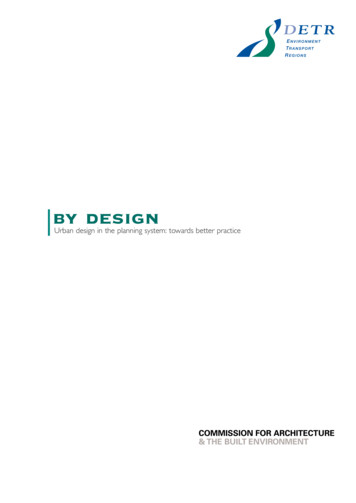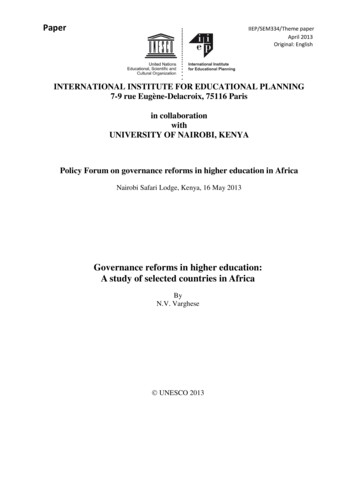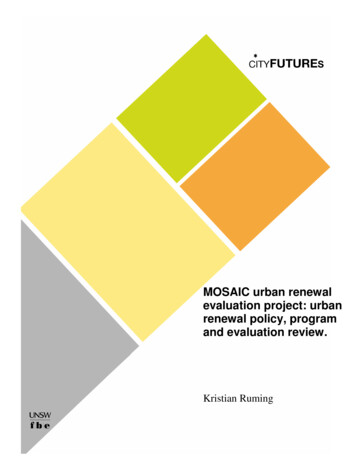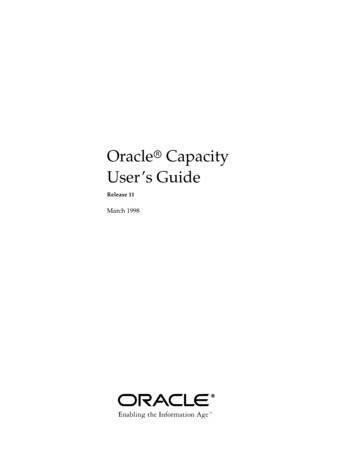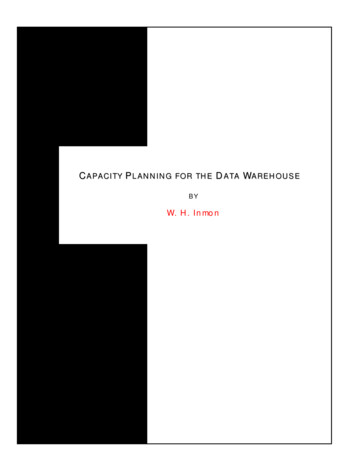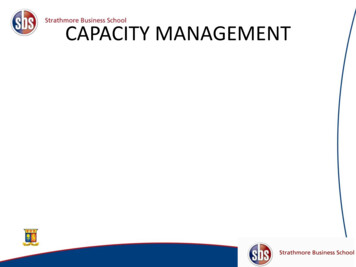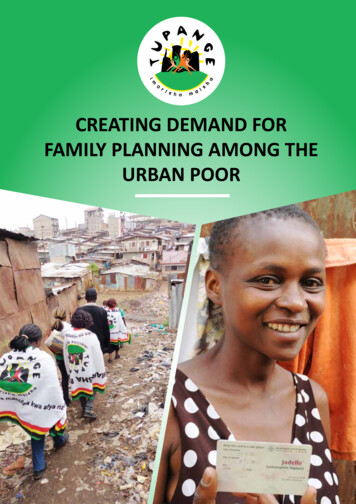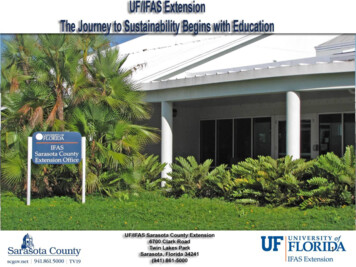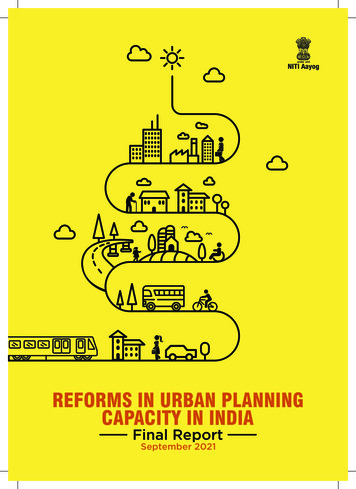
Transcription
REFORMS IN URBAN PLANNINGCAPACITY IN INDIAFinal ReportSeptember 2021
REFORMS IN URBAN PLANNINGCAPACITY IN INDIASeptember 2021GOVERNMENT OF INDIANEW DELHI
Copyright@ NITI Aayog, 2021NITI AayogGovernment of India,Sansad Marg, New Delhi - 110001, IndiaReport and Cover Design by YAAPEvery care has been taken to provide the correct and up to date information alongwith references thereof. However, NITI Aayog shall not be liable for any loss or damagewhatsoever, including incidental or consequential loss or damage, arising out of, or inconnection with any use of or reliance on the information in this document. In caseof any doubt or query, readers are requested to refer to the detailed document linksprovided under the reference section. Readers of this document should be aware thatthe document may be subject to revisions. Any suggestion/input may please be sentto rakesh.desai@gov.in
COMPOSITION OF THE ADVISORY COMMITTEE FORREFORMS IN URBAN PLANNING CAPACITY IN INDIA(Constituted vide OM dated 22nd October 2020)ChairpersonDr. Rajiv KumarVice-Chairman, NITI AayogMembersSh. Amitabh KantCEO, NITI AayogSh. Durga Shanker MishraSecretary, MoHUASh. Amit KhareSecretary, Higher Education, MoESh. Sunil KumarSecretary, MoPRDr K. Rajeswara RaoSpecial Secretary, NITI AayogDr D.P. SinghChairman, UGCProf. Anil D. SahasrabudheChairman, AICTEMs D. TharaJoint Secretary, MoHUA& Chairperson, TCPODr Bimal PatelProf. Dr. P.S.N. RaoPresident & Acting Director,CEPT University, AhmedabadDirector, School of Planning and Architecture,New DelhiProf. Dr. D.S. MeshramSh. Hitesh VaidyaFormer President,Institute of Town Planners, IndiaDirector,NIUA, MoHUASh. Rakesh DesaiConvener of Committee & Director,NITI Aayog
Dr Rajiv KumarVice-ChairpersonNational Institution for Transforming IndiaGovernment of IndiaNew Delhi, IndiaUrbanization is intrinsic to development and often serves as a major driverof economic growth. As India reaches tipping point of transitioning from amostly rural to an urban society, the focus must be on ensuring the bestopportunities for economic growth for all sections of the society.It is a matter of concern that despite huge investment, our cities still facemany efficiency-and sustainability-related challenges. None of our citiesfeature among the top 50 cities in many global rankings.The need of the hour is incisive, insightful planning – in the absence ofwhich neither investments nor actions would be able to yield long-termsolutions. Unplanned urbanization could result in serious downsides.The state of human settlements could become a silent crisis in motion.We need to urgently and significantly ramp up the present cumulativecapacity of urban planning in the country to avoid the creeping and silentcrisis that is overtaking human settlements.This committee focused on arriving at recommendations that can becatalytic in nature and can unblock bottlenecks in the value chain of urbanplanning capacity in India.The lack of human resources has emerged as a major bottleneck in theState machinery responsible for urban planning and design. At the same,it is rather ironic that the country also lacks sufficient demand for qualifiedurban planners in both the public and private sectors. There were severalother impediments observed in the entire value chain – most of whichappear to be due lack of awareness about ‘urban planning’ and its utility pervForewordCities are like living organisms. For them to flourish, it is important thattheir economic and social infrastructure are in a sound state. There areenormous possibilities to achieve this through adoption of spatial planningtools. We must rethink, reimagine and re-establish the very purpose andapproach towards planning of cities and towns in India.Foreword
se. A set of major reforms have been recommended to strengthen India’surban planning capacity-technically, organizationally, and institutionally.I commend Dr. K. Rajeswara Rao, Special Secretary, NITI Aayog, forconceiving and taking forward this initiative and successfully bringingit to completion. My congratulations to Sh. Rakesh Desai, Director, NITIAayog, for ensuring time bound actions as convener of the committee.A special appreciation to Ms. Anshika Gupta, Senior Associate, for herideas and insights.We hope that this report will stimulate conversation and action on bringingabout a qualitative improvement in urban planning capacity. The road toreform may be long. The time to start is now, if the country has to keeppace with the emerging demands of time.A new phase of action must begin with this effort.I extend my best wishes and support to all the member Ministries, Stategovernments and urban local bodies who will be the real drivers behindthe implementation of these recommendations to bring about sustainableand equitable growth in the coming years.Dr. Rajiv KumarForeword6 August, 2021New Delhi,Indiavi
Sh. Amitabh KantChief Executive OfficerNational Institution for Transforming IndiaGovernment of IndiaNew Delhi, IndiaUrbanization is the key to India’s future. Our cities occupy just 3% of thenation’s land, but their contribution to the GDP is a whopping 60%. Indiais swiftly moving forward for becoming half urban in a couple of decades.This would bring enormous opportunities of economic growth and globalcompetitiveness. Efforts must be channelised to ensure preparedness ofthe nation to manage such a massive urban transition and save our citiesfrom the clutches of unplanned urbanization and unregulated constructionactivities.Over the years, the country has witnessed the expansion of cities basedon car-centric planning. However, the future of urban mobility and urbanliving needs to evolve on the back of public transportation. The cities needto be very compact and adopt a circular economy system to minimizetheir negative impacts on the environment. A global city like Singaporewas raised through firm political leadership, a professional approach,and intelligently created capacities. Therefore, it is not just importantto enhance the number of urban planners in India but to also ensure asimultaneous improvement in the quality of planning.Of the 7933 towns that are accounted as urban, almost half have a statusof census towns and they continue to be governed as rural entities.With business as usual, the country may become a haven for unplannedurbanization. This needs planning interventions at a massive scale, whichcould be fostered by private sector companies through their problemsolving capacities and efficiencies. However, currently the ecosystem forthe development of private sector companies and start-ups in this domainis not robust enough to meet the needs.viiMessageOur urban planning machinery has not grown at the pace of the demandsposed by urbanisation and global technological advancements. Urban localbodies face a massive shortage of skilled and trained human resources aswell as financial challenges. Furthermore, poor quality of planning is a hugelimiting factor to realize the true economic potentials of urbanization.Message
If the country has to witness a quantum leap in its planning capacities,the private sector companies need to be nourished and developed-toprovide innovative solutions to the public sector and good quality jobsto the future urban professionals. On the front of the education systemof urban planning, a lot needs to be done to ensure that future plannersare equipped with all the technological prowess and multi-disciplinaryexpertise to pave the socio-economic progress of the cities as well asthe upcoming rural settlements.This report, prepared by the Advisory Committee on ‘Reforms in UrbanPlanning Capacity in India’ chaired by the Hon’ble Vice Chairman NITIAayog, has come at a critical time.This is a remarkable initiative steered by NITI Aayog wherein multiplediscussions with experts, decision-makers and stakeholders wereundertaken during last 9 months. I congratulate Dr. K. Rajeswara Rao,Special Secretary, NITI Aayog, for spearheading such a landmarkachievement and Mr. Rakesh Desai, Director, for managing it in atimebound manner. I appreciate the excellence demonstrated by Ms.Anshika Gupta, Senior Associate, NITI Aayog, through ideation of thisvital pursuit, and generation of its technical discourse.I request the member Ministries, State Governments and the citygovernments to review this report and build upon it further to createstrategies for immediate, mid-term, and long-term actions. Only with amass movement can we all create a new ethos and dynamism for India’surbanization. 6 August, 2021 New Delhi,IndiaMessageSh. Amitabh Kantviii
Dr K. Rajeswara RaoSpecial SecretaryNational Institution for Transforming IndiaGovernment of IndiaNew Delhi, IndiaI am sincerely grateful to Dr Rajiv Kumar, Vice Chairman, NITI Aayog forleading us with his visionary insights and Sh. Amitabh Kant, CEO, NITIAayog for his encouragement to take the efforts ahead. I would also like toexpress my gratitude to Dr Gyanendra Badgaiyan, Resident Senior Fellow,IDFC Institute for providing valuable insights into the sector.My deep regards to key functionaries in the Advisory Committee namely,Sh. Amit Khare, Secretary, Higher Education, MoE, Sh. Durga ShankerMishra, Secretary, MoHUA & Sh. Sunil Kumar, Secretary, MoPR, Dr. D.P.Singh, Chairman, UGC, Prof. Anil D. Sahasrabudhe, Chairman, AICTE andMs. D. Thara, Joint Secretary, MoHUA & Chairperson, TCPO. I expressmy gratitude to the eminent experts namely Dr. Bimal Patel, President &Acting Director, CEPT University, Ahmedabad and Prof. Dr. P.S.N. Rao,Director, SPA, New Delhi for providing valuable insights about issuesrestraining the urban planning capacity in India.I thank Sh. Hitesh Vaidya, Director, NIUA for supporting the committee.I also thank Dr. D.S. Meshram, Council member & Former President,Institute of Town Planners India for his kind cooperation. I would also liketo appreciate the efforts put in by Sh. Rakesh Desai, Director, ManagingUrbanization vertical who was also convener of the committee. Withproactive participation of all the members, this task achieved muchheadway in a limited time.I would also like to place on record my appreciation to Sh. R. Srinivas,Head-Metropolitan planning and Union Territories Division, TCPO forixAcknowledgementsUrbanisation has been knocking at the doors, it has the power to transformthe country and set it rolling towards economic transition. Is the countryprepared enough to plan or manage the projected urbanisation or wouldit be left to the chances of survival through laissez-faire? This questionled to multiple discussions, and ultimately to the formation of an interministerial Advisory Committee.Acknowledgements
his support throughout the journey. A special thanks to Dr DebjaniGhosh, Associate Professor, NIUA who has supported the committeewith noteworthy need assessments and research inputs. During thetenure of the committee, many experts as enlisted in the list of keycontributors have pro-bono contributed towards the ideation ofreforms. I acknowledge their support and express my gratitude to themfor extending their cooperation.Last but certainly not the least, I would like to appreciate the effortsof Ms Anshika Gupta, Senior Associate, Town Planning and UrbanFinance, NITI Aayog, who showcased remarkable technical excellencewhile leading this task. She formulated the need for Committee byauthoring several concept notes and assisted it in its strategic steering.The editorial and research assistance provided by Ms Pragya Sharmaand Ms Himanshi Gupta was found promising.The working of this committee was truly an endearing and enrichingjourney. It created a stir among technocrats and opened many policyquestions at national as well as international forums. Utmost care hasbeen taken to ensure the clarity and correctness in the report and itsannexures. However, if any factual errors are observed, the same maykindly be informed. The overall effort was collaborative, exhaustive, andconsultative. I hope that this report shall serve as a key for undertakingmuch needed long-term reforms in the urban sector. 6 August, 2021 New Delhi,IndiaAcknowledgementsDr. K. Rajeswara Raox
The first meeting was held on 17 November 2020, wherein the Chairpersonexpressed a strong need for reformative actions in urban planning capacityof the country. Consequently, the work and title of the committee wasexpanded and changed to ‘Reforms in Urban Planning Capacity in India’.This laid a foundation for extensive discussions with eminent experts,brainstorming sessions on several thematic areas like curriculum, capacitybuilding and human resources, side events on efficient utilisation of urbanland and urban housing, data collection and analysis, and convergence ofideas from literature. Over a period of 9 months, more than 10 consultationswere undertaken, 4 reputed think tanks/CSOs were consulted, inputsfrom 8 organisations were sought, and feedback from over 30 academicinstitutions was mapped. The second meeting of the committee washeld on 12 March 2021, which brought several crucial issues to the fore.During the third meeting of the Advisory Committee held on 18 June 2021,extensive discussions were undertaken on the draft recommendationsand a way forward was prepared.xiPrefaceConsidering the projected trend of urbanization, the multiple challengesbeing faced in the cities and India’s commitments towards global agendas,NITI Aayog constituted an Advisory Committee on ‘Reforms in UrbanPlanning Education in India’ in October 2020. This high-level committeewas formed under the Chairpersonship of Dr Rajiv Kumar, Vice Chairman,NITI Aayog. It comprised 14 members: CEO, Special Secretary and Directorof NITI Aayog; Secretaries of three key Central Ministries—MoHUA, MoPRand MoE; Chairpersons of UGC, AICTE and TCPO; Directors of two leadinginstitutions—CEPT University, Ahmedabad, and SPA Delhi; Director, NIUA;and President, ITPI.Preface
This report presents a condensed outcome of the deliberations with thecommittee members, eminent experts, academia and professionals. It hasbeen structured into 7 chapters as described below:Preface Chapter 1 presents the need for reforming urban planning capacityin India. It articulates multiple transitions, including those related todemographic, policy, and finance, that the country is witnessing. Itdiscusses the key urban challenges as well as immense relevance of‘planning’ skills to address these challenges. Chapter 2 presents a brief summary about the previous committeesin the domain, the genesis of Advisory Committee and processesundertaken by it to position the intellectual dialogue in presentcontext. Chapter 3 summarizes the evolution of planning of human settlementsin India throughout different ages. Chapter 4 briefly describes the situation of human resource capacitiesand identifies demand-supply gaps for urban planning in the Statetown planning departments and rural planning capacities for theimplementation of ongoing schemes. Chapter 5 illustrates the supply capacity, regional distribution, andcurriculum aspects of urban planning education to present a biggerpicture of opportunities, and the potential of strengthening theeducation of all ‘planning’ specialisations in India. Chapter 6 presents an overview of the critical issues emanatingfrom each chapter leading finally to Chapter 7 that puts forthrecommendations.xii
f Summary of the Reportxv1.2 The Urban Challenges1.3 Planning Skills to Address Urban Challenges2. GENESIS OF ADVISORY COMMITTEE2.1 Prominent Committees in Near Past61320202.2 Constitution of Advisory Committee By Niti Aayog, 2020232.3 Defining ‘Urban Planning Capacity of India’242.4 Techno-Consultative Processes Undertaken293. EVOLUTION OF URBAN PLANNING IN INDIA3.1 Tracing Origins and Development Stages3.2 Policy Narrative Post Independence–5 Year Plans (1947–2014)3.3 Policy Narrative 2015 Onwards4. PUBLIC SECTOR CAPACITY4.1 Urban4.2Rural5. EDUCATION SECTOR CAPACITY5.1 Evolution of Urban Planning Education5.2xiii11Regulatory Framework41414451535362Contents1. Need for Reforming Urban Planning Capacity1.1 Transitions and Targets666667Contents
5.3Centres of Education5.4Model Curricula Development in India715.5Supply Estimation725.6Key Inferences756. CRITICAL ISSUES787. RECOMMENDATIONS857.1Programmatic Interventions for Planning of Healthy Cities857.2Programmatic Interventions for Advancement inDevelopment Control Regulations877.3Ramping Up Human Resources in Public Sector897.4Ensuring ‘Qualified’ Urban Planners in Services907.5Mainstreaming Capacity Building917.6Rejuvenation of Capacity-Building Institutions927.7Re-Engineering Urban Planning Governance937.8Revision of Town and Country Planning Acts937.9De-Mystifying Planning and Involving Citizens947.10 Building Local Urban Leadership957.1196Steps for Enhancing Role of Private Sector7.12 Steps for Strengthening Urban Planning Education SystemContents70987.13 Creation of National Digital Platform of Town andCountry Planners1027.14 Constitution of a ‘National Council of Town andCountry Planners’ (NCTCP)103References105List of Key Contributors111Key Messages115xiv
Reforms in Urban Planning Capacity in IndiaBRIEF SUMMARY OFTHE REPORTIndia is the second largest urban system in the world with almost 11% of the total globalurban population living in Indian cities. In absolute numbers, the urban population inIndia is more than highly urbanised countries/regions across the globe. The country hasreached a turning point in its journey of its economic transformation wherein half ofthe country would be ‘urban’ in a few decades. Urban growth is expected to contributeto 73% of the total population increase by 2036 (MoHFW, 2019).Over the years, cities have expanded and become burdened by the stresses and strainsof unplanned urbanization, the brunt of which is faced by the poor and the marginalised,the biodiversity and the economy. In fact, Covid-19 revealed the dire need for planningand management of our cities, with an emphasis on the health of citizens.Issues like lack of availability of serviced land, traffic congestion, pressure on basicinfrastructure, extreme air pollution, urban flooding, water scarcity and droughts arenot merely a reflection of infrastructural shortcomings in the cities. These issues indicatea deep and substantial lack of adequate urban planning and governance frameworks.xvBrief Summary of the Report
Reforms in Urban Planning Capacity in IndiaOver the last few years, a lot of efforts has been made by the Centre and the StateGovernments in the urban sector. However, urban planning, which is the foundationfor the integrated development of cities, citizens, and the environment, has notreceived adequate attention.For this reason, as the State and city governments continue to solve urban issues in afirefighting mode, urban areas struggle to achieve ‘basic services for all’.For long-term sustainable urban transformation, systemic issues need to be identifiedand addressed. India’s urban story may be lauded globally or suffer irreversibledamages in the next 10-15 years depending upon corrective policy measures andactions taken at the beginning of this decade.Several bottlenecks and impediments have been restricting urban planning capacityin the country. To begin with, a significant proportion of urbanization in the countryis unacknowledged and unaddressed. Almost half of the 7933 ‘urban’ settlements arecensus towns, that is, they continue to be governed as ‘rural’ entities. Small and mediumtowns face vulnerabilities due to rapid growth and inadequate planning. Moreover,several studies have indicated that the current definitions of ‘urban’ are not reflectiveof the extent of urbanization that the country has already witnessed.Secondly, the transfer of the urban planning function from States/UTs to electedurban local governments did not happen as was envisaged through the Constitutional(Seventy-Fourth amendment) Act 1992. Many agencies are involved in urban planning,implementation, infrastructure development at the city as well as State levels. Theexisting framework has become complex, which often leads to overlapping of functions,lack of accountability and coordination, time delays, resource wastage, etc.Master plans are statutory instruments to guide and regulate the development of citiesand are critical for managing urbanization as well as ‘spatial sustainability’. However,65% of the 7933 urban settlements do not have any master plan. This leads topiecemeal interventions, haphazard constructions, urban sprawl, and environmentalpollution, which can further aggravate issues such as traffic congestion, flooding,etc. Various shortcomings in the approaches of city planning and bottlenecks in planimplementation too need to be resolved.Urbanizable/developable land is costly as well as limited in supply. City governmentsguide and regulate development through planning regulations and building bye-laws.In many cities, development control regulations were formulated several decadesago and have been updated arbitrarily without sufficient empirical evidence on theirimpacts. Recently, most States/UTs have revised their respective bye-laws basedon the Model Building Bye Laws 2016 (MoHUA, 2016). It is imperative that the citygovernments adapt the model regulations and as per their context and economicgrowth drivers. Also, there is a need to shift from text-based to form-based regulationsto ensure the optimum use of urban land and enable development based on a suitableurban form.In urban areas, land is confronted with competing uses due to market forces, socialnecessities, as well as environmental concerns. If the land use plan of a city divergesfrom the status of land records, it may not get implemented on ground. Moreover, suchBrief Summary of the Reportxvi
Reforms in Urban Planning Capacity in Indiadivergences become a potential cause of unnecessary and time-consuming disputesand litigations. Accurate cadastral maps and clarity about property rights are veryimportant for successful planning. Such maps do not exist with the city functionariesor in the public domain for most Indian cities. This a big impediment in the planningprocess.Massive capacities for problem-solving, innovation, and ideation are required to addressthe present and future challenges in the planning and management of cities, towns,villages and their infrastructure. It may not be feasible to create such capacities inthe public sector given the size and scale of urbanisation in India. Over the years,many private sector companies developed in India in the domains of architecture, civilengineering and construction. However, the ecosystem of the private sector in urbanplanning domain has remained under-developed.Human resource is indispensable to strengthen the urban planning capacity in thecountry. A study conducted by TCPO and NIUA for NITI Aayog indicates that over12,000 posts for town planners are required in the State town and country planningdepartments. This is in stark contrast to the present situation. There are fewer than4000 sanctioned positions for ‘town planners’ in these departments, half of whichare lying vacant. An inadequate number of urban planners in the State planningmachineries and lack of multi-disciplinary teams are serious issues. Also, in severalStates, ironically, a qualification in town planning is not even an essential criterion forsuch jobs.The country has been producing graduates with degrees such as Bachelor of Planningsince more than 3 decades and Master of Planning since early 1950s. However, sofar, the urban planning profession has not yet gained a strong and unique identity ofits own. As a result, prospective employers, unaware of these courses and skill sets ofavailable graduates, end up hiring professionals from other disciplines to undertake thetasks of planning, thereby creating a negative feedback loop. This restrains the growthof urban-planning capacity in the country in terms of quantity of fresh graduates aswell as the quality of work being delivered in this sector.There are only about 7000 registered members in ITPI, a professional body of townplanners in India. However, this institute is not a statutory body and its membershipis voluntary. In the absence of an end-to-end system to track the number of urbanplanners who graduate every year, a fallacious sense of sense of shortage is created.The supply of urban planners needs to be supported with adequate job demand and notjust the perceived need for planners or planning of cities. Planners must be organizedin private sector companies to be able to deliver services or entrusted with roles ofplanning in public sector organisations. Till this doesn’t happen, this workforce willremain unutilized and demand–supply will be disconnected.There are 49 educational institutions across India that provide degree programmesin urban planning and allied specialisations and nomenclatures like EnvironmentalPlanning, Transportation planning, Housing, Infrastructure planning, and so on. Theseare distributed across the country, barring the North-Eastern States (except Assam),Western Himalayas and UTs (except New Delhi). Multiple nomenclatures of degreesxviiBrief Summary of the Report
Reforms in Urban Planning Capacity in Indiacreate problems in the absorption of qualified graduates—AICTE has an approvedlist of 25 nomenclatures for postgraduate degrees in planning.Observing India’s urbanization through Western lens has become a practice . Experiencehas shown that such objectivity diminishes the motivation and confidence neededto generate innovative solutions for indigenous problems. Indian cities are differentfrom their Western counterparts in terms of culture, demography, lifestyle and so on.Adopting Western practices without tailoring them to suit Indian needs is not advisable.There is a lack of synergy between urban and rural planning and development. TheState Town and Country Planning Acts need to be revisited to harmonize the two.The platforms for citizen participation and their awareness about the process ofurban planning and development are limited. There is a perceptible communicationgap between planning agencies and the people, who are the ultimate beneficiaries.With the ‘business as usual’ scenario, human settlements may become dysfunctionaland, in turn, generate serious socio-economic impacts. Therefore, there is an immenseneed for significant reforms across the value chain of urban planning in the country.The Advisory Committee focused on devising measures to strengthen the three pillarsof cumulative urban planning capacity in the country: public sector, education/research sector, and private sector. And on identifying ways to create a robust feedbackloop that helps one pillar strengthen the other.The recommendations of the Advisory Committee are: Programmatic intervention for planning of healthy cities: Every citymust aspire to become a ‘healthy city for all’ by 2030. This would need aconvergence of multi-sectoral efforts at the intersections of spatial planning,public health, and socio-economic development. Also, the focus of planningurban development must encompass not only the million-plus cities butalso hundreds of small- and medium-sized towns. The Advisory Committeerecommends a central sector scheme ‘500 Healthy Cities Programme’, for aperiod of 5 years, wherein priority cities and towns would be selected jointlyby the States and the local bodies. Programmatic intervention for optimum utilization of urban land: All thecities/towns under the proposed ‘Healthy Cities Programme’ should strengthendevelopment control regulations based on scientific evidence to maximizethe efficiency of urban land (or planning area). The Advisory Committeerecommends a sub-scheme ‘Preparation/Revision of Development ControlRegulations’ for this purpose. Ramping up of human resources: The public sector must have an adequateworkforce in terms of quantity and quality to tackle the challenges ofurbanization. The Advisory Committee recommends that the States/UTs mayneed to a) expedite the filling up of vacant positions of town planners, and b)additionally sanction 8268 town planners’ posts as lateral entry positions fora minimum period of 3 years and a maximum of 5 years to close the gaps.Brief Summary of the Reportxviii
Reforms in Urban Planning Capacity in Indiaxix Ensuring qualified professionals for undertaking urban planning: Urban areasand their developmental complexities have increased over the years. Thediscipline of urban planning or town planning has a dedicated course curriculawith which graduates acquire a multi-sectoral overview and skillset to addresssuch challenges. The States may need to undertake requisite amendments intheir recruitment rules to ensure the entry of qualified candidates into townplanning positions. Mainstreaming capacity-building activities and rejuvenation of capacitybuilding centres: Concerted efforts are required by the States/UTs to ensureregular capacity building of their town planning staff. Also, the existing centresof excellence established by MoHUA and State-level training institutions needto be further strengthened to regularly build the skills and expertise of urbanfunctionaries. Re-engineering of urban governance: There is a need to bring in moreinstitutional clarity and also multi-disciplinary expertise to solve urbanchallenges. The Advisory Committee recommends the constitution of a highpowered committee to re-engineer the present urban-planning governancestructure. The key aspects that would need to be addressed in this effort wouldbe: i) clear division of roles and responsibilities among various authorities,appropriate revision of rules and regulations, etc., ii) creation of a moredynamic organizational structure, standardisation of the job descriptions oftown planners and other experts, and iii) extensive adoption of te
to be very compact and adopt a circular economy system to minimize their negative impacts on the environment. A global city like Singapore was raised through firm political leadership, a professional approach, and intelligently created capacities. Therefore, it is not just important
